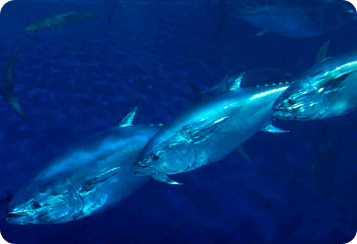Motion in the ocean is all about shakin’ your booty -- if you’re a fish, that is.
 Tuna can maintain high speeds for a long time. Credit: Monterey Bay Aquarium / TOPP
Tuna can maintain high speeds for a long time. Credit: Monterey Bay Aquarium / TOPPA fish swims by contracting a complex network of muscles along the sides of its body, known as myomeres. The contractions “bend” the fish’s body, creating a wave that pushes against the water. The wave also moves the fish’s tail fin back and forth, which pushes against the water like an oar, generating most of the forward push.
But not every fish pushes in the same way. Swimming speed, agility, and endurance depend on the shape of the fish and its tail.
Long, slender fish like eels undulate through the water just as snakes undulate across the land. Their tails are relatively small, so they don’t add much to the thrust generated by the body itself.
Fish with rounded tails tend to be fairly slow swimmers, while those with forked or crescent-shaped tails tend to be the fastest.
The fastest and strongest swimmers of all are those whose bodies taper to a thin strand that supports a large, wide tail. This group includes tunas, which can maintain high speeds for a long time, and great white sharks, which must generate a lot of power to move their large bodies quickly enough to catch a meal.
A few fish, such as rays and skates, move not by swishing their tails, but by “flapping” their “wings.” They have the same types of muscles as other fish. But instead of tail fins, the muscles move large fins on the sides of the body, creating waves that push the fish forward -- a slightly different way to generate motion in the ocean.

